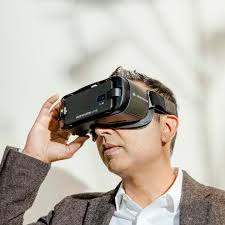Or listen in your favorite podcast app
Apple Podcasts / Google Podcasts / Spotify
The idea of virtual reality has captivated humans for the longest time. After all, the ability to live a second life, free of the physical obstacles that the real world presents is a dream worth falling into. But what if there was a bridge between the powers of virtual reality and its ability to impact the real world? That’s the mission that Ammad Khan, the CEO and Co-founder of IrisVision, set out to make possible.
“I have always believed that technology has the tremendous potential of really changing the way we do things every day. And it’s become really evident, since the launch of the smartphones in our lives and using the platform capability on the smartphone that so many of the things that we previously could not even think of have become possible.”
One way the impossible is becoming reality is through the work of IrisVision, which uses the powers of virtual reality tools to enable people who have been declared legally blind the ability to see again. On this episode of IT Visionaries, Ammad discusses the power of the IrisVision software and provides case studies on how the product is working in the real world. Plus, he details the company’s go-to-market strategy and why it was integral to develop multiple prototypes before making the product widely available.
Main Takeaways
- But First, Science: Founded in 2016, IrisVision is based on Dr. Frank Werblin’s research around retinal functions. Werblin and Khan, who possessed a background in mobile technology, worked together to find a software solution for helping individuals with low-vision see again. Virtual reality, combined with the increasing use of technology, allows the eyes to put together pixels, in order to make blurred vision more clear.
- Test, Test, Test: Before you send any product to market, you need to make sure you have a sound basis for how the product works and perform multiple use cases. Rushing a product to market without understanding how it performs under varying variables could be disastrous. Make sure you take the proper time to prototype your device so when it hits shelves, you’re off and running
—–
For a more in-depth look at this episode, check out the article below.
The idea of virtual reality has captivated humans for the longest time. After all, the ability to live a second life, free of the physical obstacles that the real world presents is a dream worth falling into. But what if there was a bridge between the powers of virtual reality and its ability to impact the real world? That’s the mission that Ammad Khan, the CEO and Co-founder of IrisVision, set out to make possible.
“I have always believed that technology has the tremendous potential of really changing the way we do things every day. And it’s become really evident, since the launch of the smartphones in our lives and using the platform capability on the smartphone that so many of the things that we previously could not even think of have become possible.”
One way the impossible is becoming reality is through the work of IrisVision, which uses the powers of virtual reality tools to enable people who have been declared legally blind the ability to see again. On this episode of IT Visionaries, Ammad discusses the power of the IrisVision software and provides case studies on how the product is working in the real world. Plus, he details the company’s go-to-market strategy and why it was integral to develop multiple prototypes before making the product widely available.
Launched in 2016, IrisVision is helping individuals diagnosed with low vision see again through the power of its software. Designed to help users overcome several degenerative effects associated with vision-loss, users can press and swipe their way to the power of vision through the use of digital lenses and a special screen.
“On the surface, you will see a virtual reality headset,” Khan said. “If you look closely, you will even identify a phone that’s mounted in front of the virtual reality headset. There is a camera on the smartphone that’s looking at the world and the camera captures a live video of what’s in front of the person’s eyes. Then our software processes that video feed and modifies it to a level that whatever remaining vision that person still has [can see]. We channel the signal to those islands and the remaining patches of vision they have picked up the signal enough to put the full picture together.”
The concept was born when Khan met co-founder and business partner, Dr. Frank Werblin, a neuroscientist who had an idea that virtual reality spectacles could be used in a way that was never before seen as a possibility.
“Virtual reality headsets were available and the smartphone had reached this milestone where the screen resolution and the power of the camera is just enough for us to build this technology,” Khan said. “So instead of starting from scratch, we are able to leverage a lot of the pieces that have now become available.”
Smartphones had already become advanced enough that combined with powerful enough software, they could fundamentally change the future of vision. But the key was to find out if what Khan and Werblin had constructed could make a tangible difference to the person wearing the headset.
“Frank at the time had a neighbor in the Bay Area — a lady who used to sing in the choir and had lost her vision and was devastated because of the vision loss,” Khan said. “Frank took our prototype to this lady and I think she was probably one of the first people who tried our headset and she was blown away. I still remember watching because we were videotaping this on a smartphone and the reaction was something that just changed my life forever. All of a sudden, she starts recognizing things that she thought she would never [see again]. And that was our first proof actually working.“
But one case study wasn’t enough. Khan knew he and his team had to continue to refine their prototype because launching such an important piece of technology without conducting multiple use cases could prove disastrous.
“We went through several iterations of the product — the user interface and developing the technology further, which enabled us to go from a prototype stage to a stage where we felt we had tested the product across at least seven or eight different eye conditions included in that patient group, always fine-tuning the user experience, and then thinking about what else do we need to turn this into a product?”
So what’s next for IrisVision? Khan said he foresees the company adding multiple applications within the current software base to fully expand the functionality of the device. While giving people the power to see again is more than enough, he believes there is still the possibility to add an entertainment aspect to the device.
To hear more about IrisVision and the details behind the product, check out the full episode of IT Visionaries.
—
To hear the entire discussion, tune into IT Visionaries here.





